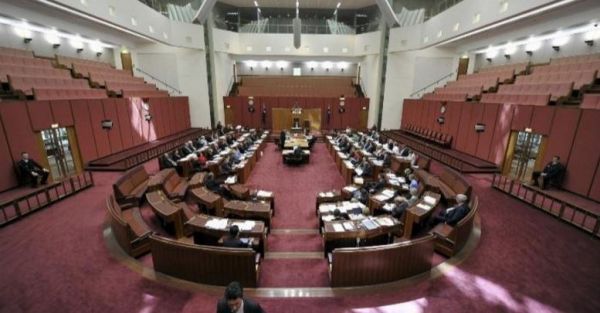The Senate Inquiry’s revelations into the construction industry’s use of dangerous and deadly building products have been truly shocking.
Although focussing foremost on cladding and asbestos, the inquiry has laid bare a lawless industry, one firmly founded on fallacies, with fake products, false certifications and fraud rife across the board. In short, it has uncovered one scandalous construction con!
This scrutiny of non-conforming building products (NCBP) has exposed an industry in defiance of any ‘compliance’. It has confirmed that the ‘governance’ agencies relinquished building control decades ago, with officials reciting the clichéd “systemic failure” as their pretext for sheltering the industry’s rogues. It has spotlighted the spin doctors’ spurious claims of a “compliant industry” and decimated any delusions of governments protecting people. Critically, it has highlighted the core legislative flaws; for the benefit of business, people’s safety was deemed irrelevant and disregarded.
Australia’s building blueprint
Australia’s building and construction industry was deregulated three decades ago. Replaced by pretend ‘governance’, the industry effectively became ‘self-regulated’. As countless independent investigations have established, the blueprint thereafter did not compel meeting even minimum building and safety standards. This was a recipe for disaster.
As those in the industry know, the official policy of non-compliance and its concomitant lack of penalties for rogue operators (regardless of negligent conduct and ignoring public safety) encouraged more to join the ranks. Once delinquency was decreed ‘legitimate’ and the three key stakeholders (consumers, sub-contractors and workers) disenfranchised, the industry quickly spiralled out of control.
In the aftermath of deregulation, another tier of unruliness was sanctioned. Overlaid on top of a totally non-compliant industry, governments endorsed the use of so-called non-conforming building products, a dumbed-down term diminishing the danger of masses of toxic and lethal materials. Just think cladding and asbestos for starters! These and hundreds of other cheap and nasty products (cabling, glass, wood and steel) have swamped the country for 25 years. In every sense, they have helped business to soar to new heights, to ‘con-struct’ more and more hideous and hazardous buildings. But at what cost to our community?
This contagion has debased our building stock. Some have labelled it “industrial disease” while others have declared our buildings to be “ticking time bombs.” Regardless, all informed persons recognize that we have created a beast – a third world built environment. What we don’t know is just how much explosive fire is in the dragon we have unleashed, how many Australians’ lives are threatened and most importantly the ultimate price for our people.
Senate stock take: what, how and why?
The 2014 Lacrosse apartment fire in Melbourne sparked this Senate Inquiry. Beginning in 2015, it initially embarked on taking stock of the variety and quantity of NCBP in Australia. However, over more than two years, its focus has changed. The first shift was in response to the horror of asbestos being installed on the Perth Children’s Hospital in 2016, with the Senate to explore how asbestos, supposedly banned in 2003, could be used in a public building to care for sick children!
Then in June 2017 after London’s Grenfell fire, the Inquiry did a turnaround with its emphasis back on combustible cladding to consider how many Australian buildings were encased in flammable cladding and the potential fallout for human carnage. In the hearings, Senators grilled down on ‘regulation’ with probing questions to public officials as to how NCBP could be so prevalent. They successfully cut through the camouflage, connected the dots and unearthed a ‘regulatory’ regime contrived to protect business – with people entirely nullified!
Combustible cladding: Aussie rules
In an endeavour to comprehend the ‘Aussie Rules’, the Senate called countless officials from the many hundreds of state and federal departments and agencies proclaimed as the building, safety and consumer regulators. Some were reluctant to come and others elected not to appear!
By the 2017 hearings, Senators were informed on Australia’ National Construction Code, (NCC) Australian Standards (AS), Building Regulations, Building Acts, and a myriad of consumer and safety laws purported to protect consumers, workers and the community. However they had become suspicious of the regulations and enforcement across the construction industry. They faced a perplexing puzzle: a nation-wide system under Aussie Rules, supported by multitudes of public officials paid to enforce compliance. Yet combustible cladding was installed on tens of thousands of buildings across the country. How could this deadly material be approved to endanger the lives of hundreds of thousands of Australians?
Bureaucracy’s ‘Clayton’s cocktail’
Searching for answers, the Senators drilled key governance officials. They discovered the bureaucracy’s ‘Clayton’s cocktail’, a melange of muddled ingredients (standards, codes, regulations and more) mixed to simulate regulation. Prepared for public consumption, Australians were supposed to swallow this cocktail and believe the construction industry was indeed regulated.
In essence, this cocktail was a fragmented regulatory regime comprised of many legislative and administrative parts muddled together and formulated to fail – but with a façade of compliance. This concoction of chaos was in effect a confidence trick to promote public confidence!
The gobbledygook of governance
The gobbledygook of governance was crafted to conceal the official objective of protecting big business. As the Senators learned, the legal framework is not written in plain English. Neil Savery from the Australian Building Codes Board (ABCB), ex-Building Commission and expert on such matters explained how deregulation removed controls:
“In the early 1990s, we introduced a performance based code which is highly sophisticated ‘regulation’; it is not something that the average individual can necessarily understand.”
Thus we learned that the unintelligible legalese of ‘governance’ was intended to hide the wild west culture and never intended to be unveiled or understood by anyone outside of officialdom!
Savery was asked why the ABCB did nothing when it was first notified about non-compliant external cladding in 2010. He replied that the ABCB “commenced the development of a national advisory note” but decided that it was “beyond the scope” of purely the ‘Code’ and thus it “could not issue a national advisory note.”
Hence fiery cladding was ‘classified’! Savery informed that there was no official recommendation to the ABCB Board until after the Lacrosse fire in late 2014. Then in February 2016, the cladding issue was incorporated into the Senior Officer’s Group (SOG) ‘Strategic Plan’ (whatever that is) where it now sits. Incredibly, Savery said the ABCB was not part of this SOG and that this issue of fake products did not pertain to “the building and control system.” Farcical!
Senator Kim Carr could not contain himself. He recalled the television series “Yes Minister” and exclaimed: “further inquiries and more investigations!” Savery added that an expert review was planned and was “currently being socialized with the building ministers.” Yes, as Savery earlier submitted, ‘regulatory speak’ is extremely sophisticated – ‘socializing’ to pick an expert!
Significantly, Savery informed the Inquiry that the ABCB is not a statutory authority. It has no regulatory, investigatory or auditing powers. Which begs the question as to its raison d’être!
In his scripted statement, Savery said that if a product was not fit for its intended purpose it is not compliant with the Code and elaborated unequivocally that “The Code does not allow this type of cladding.”
Senator Carr was grappling with the concept of an absolute standard for cladding under the Code when cladding that was incomprehensibly combustible had been approved for buildings all over Australia! Savery clarified that ‘absolute’ only related to the ‘Deemed to Satisfy’ pathway. Carr was incredulous that ‘absolute’ did not mean ‘absolute’! Carr got it! The fake products were officially sanctioned and Savery’s testimony verified that the fake legislation was too!
Amid the ambiguous gobbledygook, Carr asked Savery to explain how, in breach of the Code, thousands of buildings could have flammable cladding. Savery’s gobsmacking reply: “Because there is something in the system that is not working!”
The ‘recipe’ revealed
The Victorian Building Authority (VBA) had two officials front this Inquiry, both managing to further flummox the Senators. Acting CEO Murray Smith began by attempting to explain how three years on from the Lacrosse disaster, where 600 lives were threatened, no one had been punished. It was a hard gig, but Smith spun as well as the best of spinners. He asserted this a “complex matter”, throwing in an “investigation” and “quickly” to imply non-existent punitive action between 2014 and 2017.
Smith then distracted questioning, shifting blame from the VBA’s ‘no penalties’ policy to the now defunct Building Practitioners Board. Artfully dodging the bullet! Then asked about the number of disciplinary inquiries in the last five years, Smith pleaded dumb – there were so few, it was best ‘not to recall’!
Smith incidentally referenced the ‘recipe’ for disguising the uncontrolled industry. When asked about Victoria’s appalling regulation regime, he deviated to apprise the Senators on the two “tranches” of Victorian legislation, a business term reflecting the VBA’s fundamental function of accommodating businesses. Here, he provided insight into the reason for the ‘recipe’ – Smith alluded to “registration” and “disciplinary action” and then swiftly diverged to suggest that the VBA, which already has extensive powers, required more!
Smith’s strategic digression was to avoid any problematic discussion on the VBA’s lack of controls; hence no mention of its appalling licensing arrangements, nil enforcement or the absence of penalties for reprobates which have effectively legalized fraud.
Similarly, when questioned about the widespread use of fraudulent certificates for building products and the absence of any penalties, Smith laid the blame on Consumer Affairs Victoria and the ACCC. The ‘con-sumer’ agencies are undoubtedly woeful in the whole scam of things, but under the VBA’s jurisdiction all unconscionable cowboys who purchased/installed the contaminated cladding are registered by the VBA. It was a classic case of passing the buck to shift culpability and defend the indefensible!
As to the machinations of systemic failure, Smith deferred to Joseph Genco, a VBA technical regulatory expert who divulged the prescription for deeming non-compliant cladding as compliant:
“The NCC allows a “performance based” path, putting in “safety measures to counteract and lessen other aspects,” he said.
The Senators could not follow how non-compliant combustible cladding, not allowed under the NCC, could miraculously become ‘compliant’! Genco explained that in the context of the ABCB there is “a recipe book” – ingredients magically altered to oblige conforming status! Senator Nick Xenophon was stunned when he heard of the bizarre building ‘recipe’ book!
“It’s difficult to describe to the people outside of the industry,” Genco told the Senators.
Once more the same subtext nuanced by Savery – ‘recipes’ so ambiguous that only business and our paid officials can understand! By this stage, Senator Xenophon was incensed, saying “This is doing my head in!” And he, like many others, was doubtless very insulted!
Senator Chris Ketter fittingly summed up the ABCB, the ‘Code’ and the VBA’s legislative strategy as a “get- out-of-jail free card.” The irrational ‘recipe’ is reinforced by gobbledygook language to obscure the reprehensible reality of duplicitous ‘governance’ – and to deliver mega riches for the cowboys!
Real industry review
A number of witnesses from industry, unions and the fire services sector came forward to speak honestly at the Inquiry. Sincerely seeking genuine regulation and concerned about community safety, they injected some realism, including how the constructs underpinning the combustible cladding fiasco are symptomatic of a corrupted industry.
Graham Attwood from the Expanded Polystyrene Australia group (EPA) highlighted the loopholes in the Australian Standards and the NNC for non-fire-retardant cladding, saying that contractors “look at ways and means to minimize cost in the construction phase” whilst still “supposedly compliant.” He declared that it is a “voluntary code” with a “disincentive” to conform.
Rodger Hills from the Building Products Innovation Council (BPIC) concurred with Attwood on Australian Standards. He confirmed that the NCC does not ensure products are only used for their intended purpose, and as for Standards he said people don’t buy them, don’t read them and don’t comply with them.
“Generally people don’t use the Standard because it’s a cost burden,” he noted.
So we have the NCC and Standards taking years to write, yet no one reads them and there’s nil enforcement!
Hills informed that products and buildings become “certified” without any inspections. Attwood explained the absence of inspections as a “significant gap” with no “chain of protection.” Senator Carr added that the Senators were now aware of inspections being undertaken by totally unqualified people such as “Pizza Hut managers!” Hills agreed. In relation to the state regulators, Hills informed that these agencies do not actually inspect buildings, saying products are installed but “nobody checks.”
Then the bombshell: with regard to fraudulent certificates, Hills said it was absolutely common practice and added an example.
“The Australian Window Association has literally thousands of documents that are fraudulent,” he said.
Hills confirmed fraud was a “massive issue” across the industry and related the many attempts by the BPIC to the states about endemic fraudulent certification over years. But like hundreds of others, its persistent pleas for real rules to ensure quality, compliant and safe buildings were ignored.
Clear and present disaster
Despite the determination by the bureaucracy to hide the truth via its indecipherable legislation, the Senate Inquiry has cracked the code of falsification. It has established the facts. Residents, owners, workers, subcontractors and the community are in the midst of a devastating disaster. The ‘governance arrangements’ are riddled with fallacies and fakes, and underscored by fraud across the board. One almighty con has been visited upon all Australians. But absurdly, no one is to blame!
By Anne Paten


